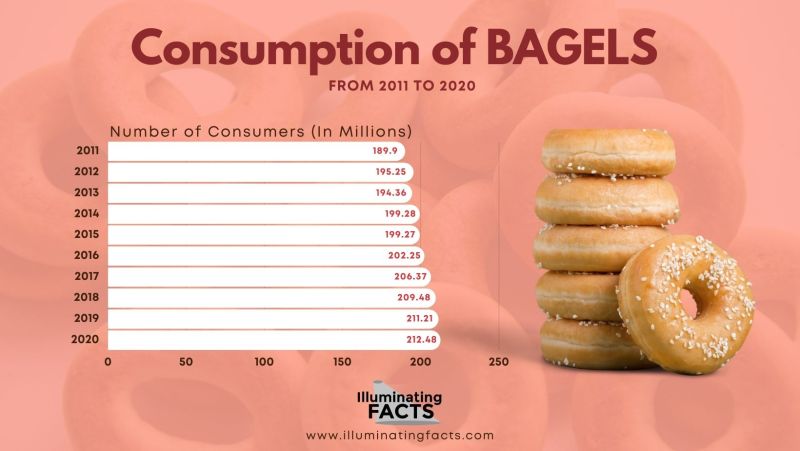All over the world, humans are adept at eating a grain-based diet to have adequate energy for daily work. Wheat is the most common staple food in the world, but processing wheat before it reaches your table has been dealt with differently all over the world. Bread is an important food throughout human history which is made from wheat and water baked in fire or cooked on a pan.
Among many types of bread prepared around the world, bagels are an important one. It is a circular bread with a hole in its center. That not only makes it easier to cook by evenly distributing heat around the dough, but it also makes it easier to carry, which might have served a better purpose in Medieval Europe. Nowadays, bagels are found with all sorts of flavors ranging from machine-cooked to hand-cooked in almost every bakery in the world.
And just to make the point – IlluminatingFacts.com has this great chart on the massive number of consumers of bagels in the United States:
Boiled-Then-Baked Ring-Shaped Bread
Bagels get their unique texture from boiling and baking, unlike a normal bread dough added to the oven directly. This idea of boiling the dough before baking was first found in the 13th-century Arabic cookbook named Ka’ak. Ka’ak is a general term for biscuits in modern Arabic, but it seems as someone improvised and invented bagels.
Discovery of Bagel
In her writings, Leah W. Leonard asserted that bagels or ‘water doughnuts’ are distinctly Jewish heritage. However, it is known that other kinds of ring-shaped bread like pretzels in Germany, taralli in Italy, obwarzanek in Poland, or girde naan among the Uyghurs are similar food products. Although it is not verified where the idea came from, Bagels originated from Ashkenazi Jews from the 17th century.
The first recorded mention of the Jewish bagel was found in 1610 in Krakow, Poland. Medieval Poland was a land of peasants and noblemen; they needed artisans and craftsmen, which were brought from Germany, where pretzels were quite common as a religious food. The Polish encouraged Jewish and German workers from the West to come to Krakow, but the pretzel was holy as it represented a monk making a prayer. This way, it was forbidden for anyone to bake it other than the Christians due to mob pressure.
The local ruler devised a solution by saying that the Jews are only forbidden from proper baking; the people following their ruler’s advice started to boil the dough and slightly roasting it. This gave birth to the first batch of bagels; when the things cooled down, the Jews started baking but kept the boiling part.
Nomenclature of Bagel
Some experts say that the word bagel comes from the Yiddish ‘beigen’, to bend, which in turn is related to ‘bouc,’ the word with the same meaning in German. It is also known that Jan Sobieski, who saved Austria from Turks, was given a yeast donut in the form of a stirrup in his honor, and it was called ‘beugel,’ which means stirrup in Austrian. It is also said that the Yiddish word ‘beygl,’ which came from the German’ bougel,’ meaning ring, is the root of the bagel word.
Official Bagel Existence in Polish Lands
The first document to mention the bagel is a 1610 sumptuary law that restrains expenditure, with wheat costing 5 times as much as rye; it was clear why this law was passed. The bagel competed with the local obwarzanek, but the Jewish elders of Krakow were specific about when and who could consume bagels. With Poland being a hub for a grain-based economy, business was blooming for Jewish bakers.
There was a riot by Christian students in the era of Sobieski, who took sticks, swords, and axes and expressed their emotions on the Jewish shops physically. Sobieski allowed bagels to be sold inside the city walls; he was a hero to the Polish, so there has been a fictitious linkage between him and the bagel. Bagels were given as a gift to women after childbirth, which slowly diffused into the Polish-Jewish culture.
With the advent of steam machines, the flour making process was quicker than ever, but the Polish economy perished after the partition of Poland, a folksong of the 19th century explained worth of bagel illustrates the earning of a Jewish artisan:
For a tailor to work
The entire week was his goal
Yet he earned only a bagel
With a hole
Migration to North America
In 1882, a lot of Jews migrated to America from Eastern Europe, which counted over 2 million people until the First World War. The Jews needed kosher food in these new colonies, so their cooking was mostly reserved. Bagel was introduced in America slowly over time, and a guidebook for Jewish settlers from Russia stated clearly that they could earn 50 cents a day, spend 10 on coffee and bagels and save 40 cents.
The number of shops that made bagels in the Lower East Side of New York was about 70 by 1900. The Jewish bakers worked in gruesome conditions in their bakeries to get their families to migrate across the Atlantic Ocean; the introduction to bagel was beautiful on the outside but not on the inside.
Bagel Bakers Union Local No. 338
Typically, young and unmarried bakers often slept in their shops without ventilation and worked 13 to 14 hours a day. In the words of Hyam Plumka, an immigrant bread carrier, every Jewish baker in a Jewish bakery used ‘spoiled eggs…’
The same kind of cheating went on in all the Jewish bakeries. There was a gross violation of labor rights everywhere.
Bagel Bakers Local 338 was a local trade union established in New York in the early 1900s whose craftsmen were the primary bagel makers in New York City. There was no machine to match their craftsmanship so they could name their price, some of those earned $150 a week when the median salary was $56 a week. This union made the dream of migrating to America come true.
Takeover by the Machines
Bagel rollers were the most skilled workers in the industry; a roller in Local 338 could make 700-830 bagels an hour. In the 1930s, the first bagels made outside New York were coming inside the city due to the introduction of dough preservatives; this led to more and cheaper bagels in town. The union tried to fight by ‘PLEASE DON’T BUY’ leaflets and other attempts, but they were blowing on a dying fire.
An automated bagel factory in 1966 made bagels that were 15% cheaper. In 1971, after merging with the local 3, the local bagel union ceased to exist. Once known as an ethnic, homemade specific food was now public, with about a million bagels being made each day.
Bagels Today
Bagels are now available in different types, from mass-produced bagels to homemade ones. But the production speed isn’t the only thing bagels have received from this era; there are now cream bagels, bagels with fillings, chocolate chip bagels, blueberry bagels, onion bagels, etc. They come in various shapes and sizes, which have countless side items and spreads to make bagels taste great.
Conclusion
Bagels started as food made to bypass the mob mentality, which slowly became an ethnic symbol of luck and happiness for Polish Jews. When it was introduced to America, the immigrants who brought this delicacy suffered from the hands of corporal greed, but labor unions helped them. When the next generation of bakers came to enjoy their heritage, the machines took over. And with the advent of machines, we can now see advancements in bagel texture, taste, and price.







